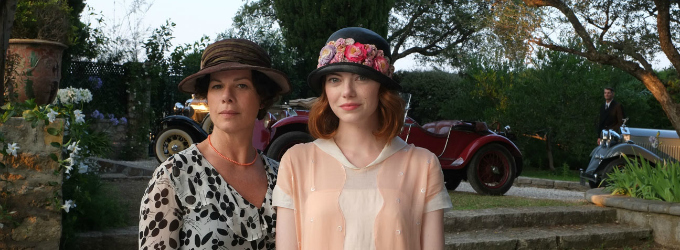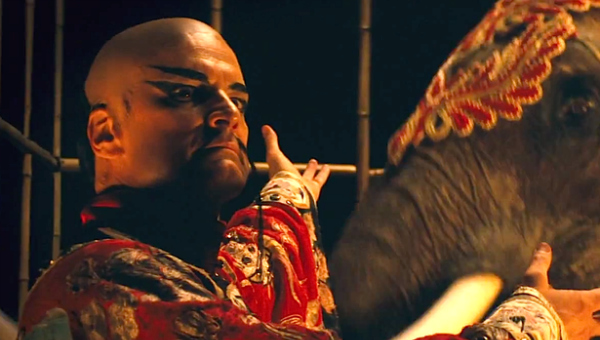
If Woody Allen’s 2013 hit BLUE JASMINE rode high on the strength of Cate Blanchett’s acting and Tennessee Williams’ plotting (the film’s indebtedness to Williams’ A STREETCAR NAMED DESIRE is undeniable), MAGIC IN THE MOONLIGHT sinks into the swamp of cinematic failure, a pale imitation of Jane Austen’s PRIDE AND PREJUDICE, weighed down by a script into which not even Colin Firth can breathe life.
Set in Southern France in the 1920s, the film looks and sounds beautiful, with sumptuous costumes and a soundtrack combining soaring classical greats with 1920s jazz. The film’s conceit is an intriguing one: renowned magician and life-long sceptic of the occult, Stanley Crawford (also known as Wei Ling Soo and Colin Firth), is called upon by his friend Howard (Simon McBurney) to help expose an American psychic, Sophie (Emma Stone), who is currently plying her trade amongst the wealthy residents of the Côte d’Azur.
There’s so much that could have been done here, not least because of the intimate connections between early cinema and magic theatre, and between magic theatre and one of Allen’s main themes in the film. In magic theatre, the intention was never to entirely pull the wool over spectators’ eyes – viewers were meant to appreciate both the illusion and the science behind it simultaneously. In the same way, we are meant to agree with Sophie that ‘going around dewy eyed’, as Crawford puts it, is essential ‘to get through life’. In the film’s light reworking of Nietzsche, we may know God is dead, but that’s all the more reason to go on believing in him. But Allen does not exploit the possibilities of these connections in the cinematography nor the plot. Instead, when Crawford travels to France to meet Sophie we get a story-line straight out of PRIDE AND PREJUDICE: class conflict, male arrogance, miraculous conversion, rejected proposals and, of course, a matrimonial happy ever after.
… the risk of this kind of filmmaking is that when the words fail, the entire film does too …
Just as Blanchett reprised her role as Blanche DuBois from Liv Ullmann’s stage production of STREETCAR for BLUE JASMINE, Firth pulls on Mr. Darcy’s lofty hauteur again for MAGIC IN THE MOONLIGHT. But where Blanchett and Austen succeed, Firth and Allen fall – there is nothing in Crawford to make him loveable, and Sophie is no more than the pretty little thing everyone so condescendingly observes her to be, diminishing in stature even more in comparison with PRIDE AND PREJUDICE’s spirited Elizabeth Bennett.
The other unfavourable comparison the film draws is with Oliver Parker’s 2002 film version of THE IMPORTANCE OF BEING EARNEST also starring, of course, Colin Firth. In EARNEST, Firth revels in the empty brilliance of Wilde’s cynical wit. In MAGIC IN THE MOONLIGHT he never manages to insert himself fully into Allen’s script, which lacks the humour, speed and self-conscious disparagement of Wilde’s and, to be fair, Allen’s, when he is at his best. Woody Allen is a film-maker who tells his stories through words, not images. When the words are good enough, it is sometimes possible to get away with this, even in a medium so visual as cinema. But the risk of this kind of filmmaking is that when the words fail, the entire film does too, as MAGIC IN THE MOONLIGHT so drearily demonstrates. In choosing to make a film about illusion and spectacle, about the power to convince people by what you make them see and believe, Allen has curiously exposed the visual blind spot in his own screen-writing and film-making powers. MAGIC IN THE MOONLIGHT convinces us of nothing, even those of us most eager to believe in a little (cinematic) magic.
Magic In The Moonlight screened on 28 Aug at 22.00 at the Cambridge Film Festival.
httpvh://youtu.be/LAwbwKURvm0


Although it is true that Mr Darcy and Blanche DuBois were seen as points of comparison with Stanley Crawford and Jasmine, respectively, in this writer’s reviews, they are only passing comparisons : leaving aside the question of how much indebtedness there is to Williams’ play, here the invective that Firth is given differs only with respect to lack of obvious swearing or coarseness to that which Allen has written in the past for himself to deliver, whether seething enviousy at Alan Alda, or seething more generally in Deconstructing Harry.
Firth is not asked to be charming deep down, and so possibly misunderstood as Darcy is, but to be abrasive and slow to commend others’ abilities, knowledge or looks, or to admit his errors and misjudgements. As to the words failing, it is far from obvious that they did – the stream of Crawford’s unbearable self-acclaim is hardly broken (and is testimony to what Howard Burkan says of him).
Emma Stone as Sophie Baker is never meant to be an Elizabeth Bennet (for, equally, she does not have younger sisters to watch over, or an elder sister who must marry first), and one would all but give the rest of the plot away to explain why.
Deep down in his plots, Allen believes in the time and the place of attraction, just as he did in Hannah and Her Sisters with Mickey, after disastrous attempts to date Hannah’s sister Holly (Dianne Wiest), encountering her quite by chance in his favourite record store, and then getting on much, much better.
If Allen wished to write a film about magic theatre, no doubt he could, but to require a séance to be something else (although magicians writing about fakery did talk about ghost-lights and the like) is hardly fair. The film does not drearily demonstrate anything, and it is not true to Allen’s work as a whole to say that he relies on the words being good (when films such as Crimes and Misdemeanours, and its reworking in Cassandra’s Dream, use – as his films do – a visual sense and, at their best, a sure sense of plot-line), and, when they are not, the film (as allegedly here) fails.